Key takeaways:
- Listening to client feedback involves understanding underlying concerns and fostering open dialogue to clarify vague comments.
- Establishing structured feedback processes, such as interviews and surveys, enhances collaboration and uncovers valuable insights.
- Analyzing feedback for recurring themes and sharing it with the team promotes collective growth and innovation in projects.
- Implementing changes based on feedback can reinvigorate the creator’s passion while improving client satisfaction and educational effectiveness.
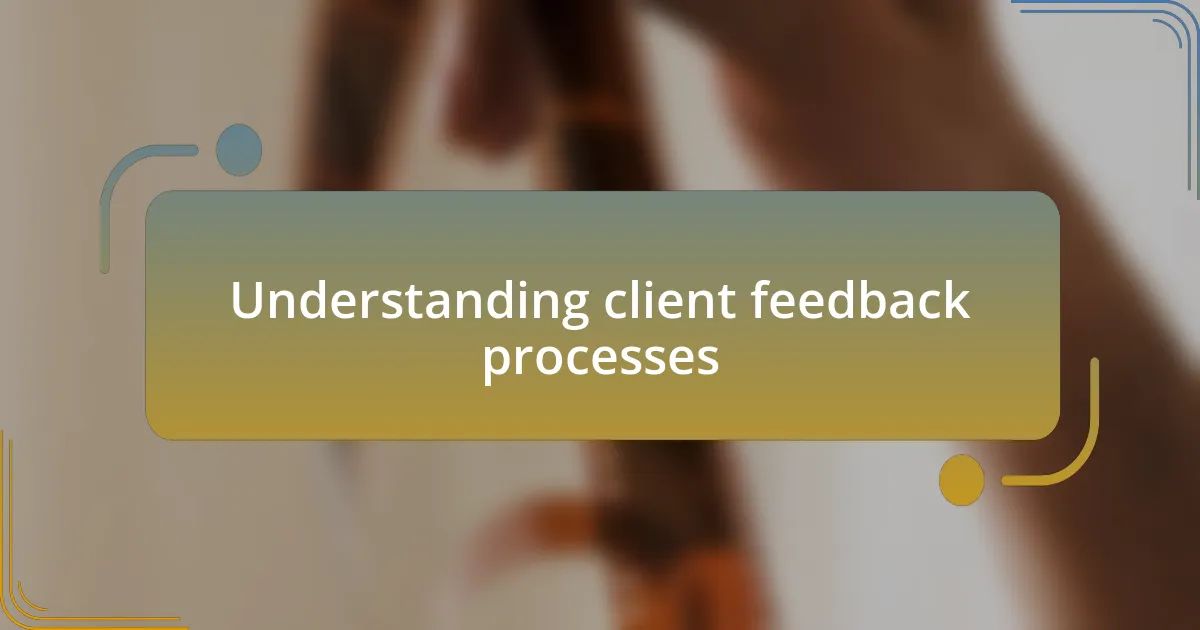
Understanding client feedback processes
Understanding client feedback processes is essential in the film industry, where perceptions can shape the success of a project. I remember when I first received feedback on a short film I produced; it was eye-opening to see how different perspectives could highlight aspects I overlooked. Have you ever considered how constructive criticism can be your best friend in refining your craft?
When working with clients, I’ve learned that listening not only involves hearing their words but also reading between the lines. For example, a client once mentioned feeling “unsatisfied” with a scene, but digging deeper revealed it was about their vision for character development. This experience taught me the importance of unpacking client input to unearth valuable insights beneath surface-level comments.
Moreover, establishing a structured feedback loop can enhance communication and understanding. I often create a simple framework that includes specific questions for clients following their initial feedback. This method not only streamlines the process but also fosters a sense of collaboration, allowing clients to feel more involved in each stage. Have you found that a systematic approach helps bring clarity and satisfaction to your projects?
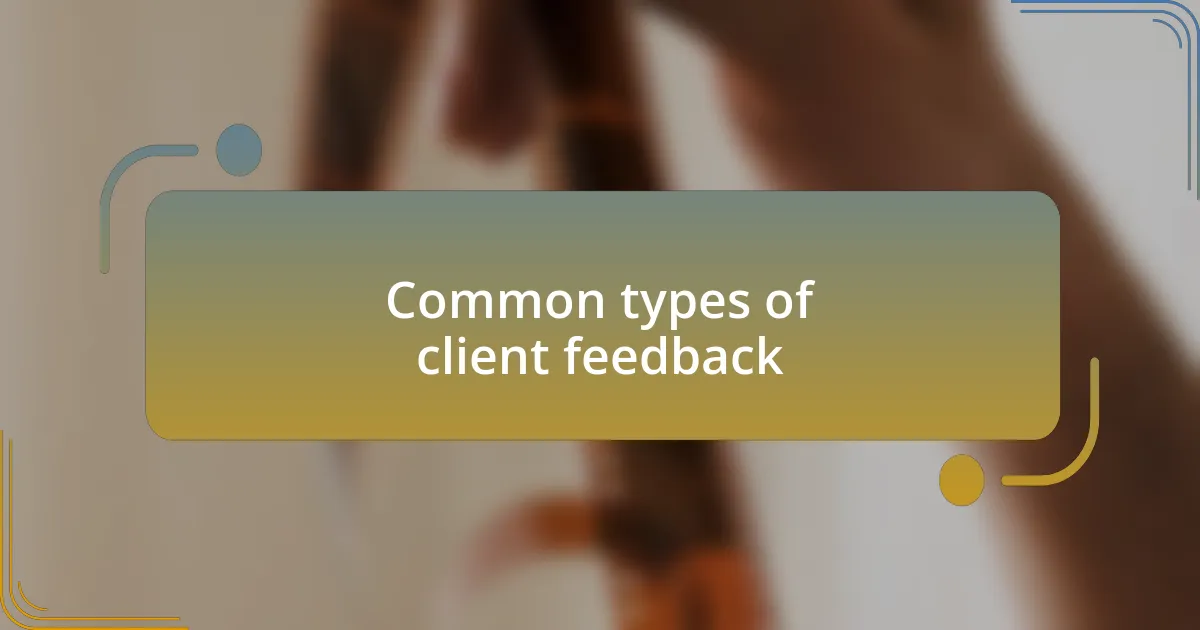
Common types of client feedback
Client feedback can vary widely, but there are a few common types that I frequently encounter. For instance, some clients may provide positive reinforcement, highlighting aspects they loved about the project. I distinctly remember a client who praised a particular scene for its emotional depth, which thrilled me because it was an element I was unsure about during production. Doesn’t it feel rewarding when your artistic choices resonate with someone?
On the flip side, I often receive constructive criticism, which, while sometimes difficult to digest, can be incredibly beneficial. One time, a director expressed concerns about pacing in my film, prompting me to reevaluate the editing process. Have you ever realized that what feels like a setback often leads to growth in your creative journey?
Another type of feedback comes in the form of vague comments, which can leave you feeling a bit lost. I recall a time when a client simply said, “It’s not quite right,” without offering specifics. This pushed me to engage them in a deeper conversation to clarify their expectations. Isn’t it fascinating how open dialogue can transform ambiguity into clear direction?
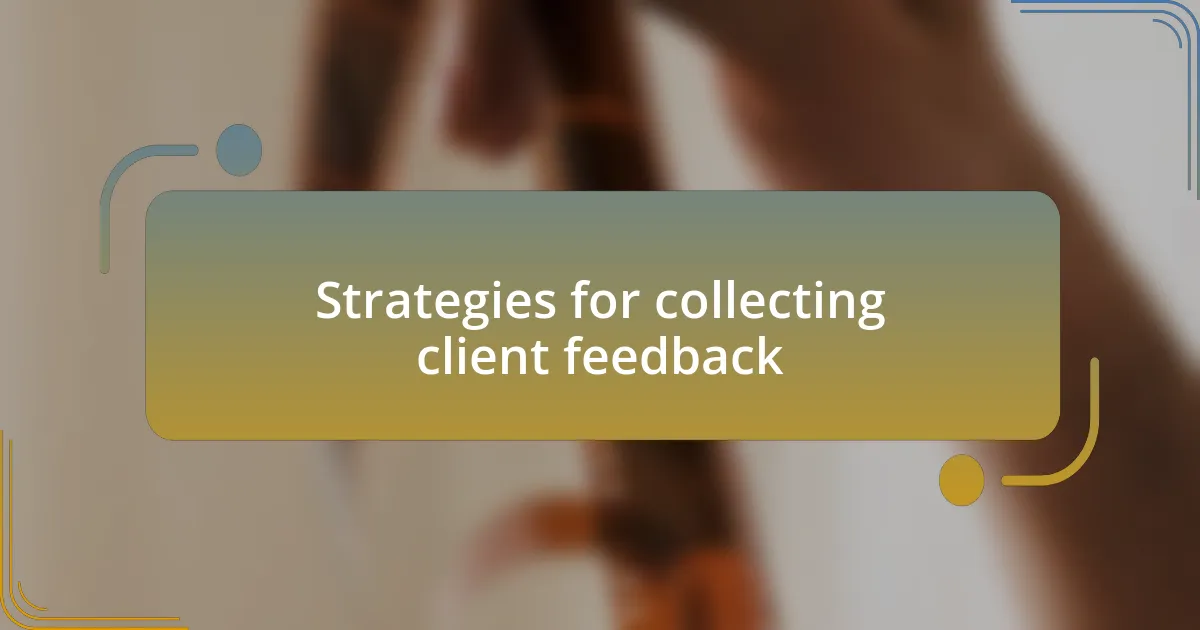
Strategies for collecting client feedback
Gathering client feedback effectively is a cornerstone of my approach. One of my preferred strategies is to conduct short, informal interviews after project completions. I once had a heartfelt discussion with a producer who candidly shared their thoughts on the collaborative process. Listening to their insights not only strengthened our professional relationship but also gave me invaluable perspective for future projects. Have you ever noticed how a relaxed conversation can unearth gems of feedback that formal surveys often miss?
Another technique I find useful is implementing brief online surveys. I remember sending out a simple questionnaire after a film workshop and was amazed by the responses. Participants appreciated the ease of providing feedback at their convenience, and the insights were direct and actionable. Isn’t it interesting how technology allows us to keep the feedback loop open, making it easy for clients to express their views?
I also use focus groups with select clients to gather in-depth feedback on specific projects. For instance, while developing a new curriculum, I convened a small group of students and industry professionals to discuss their experiences. Their diverse perspectives not only helped refine the content but also revealed common questions and expectations that I hadn’t anticipated. Are you aware of how powerful collective insights can be in shaping your future endeavors?
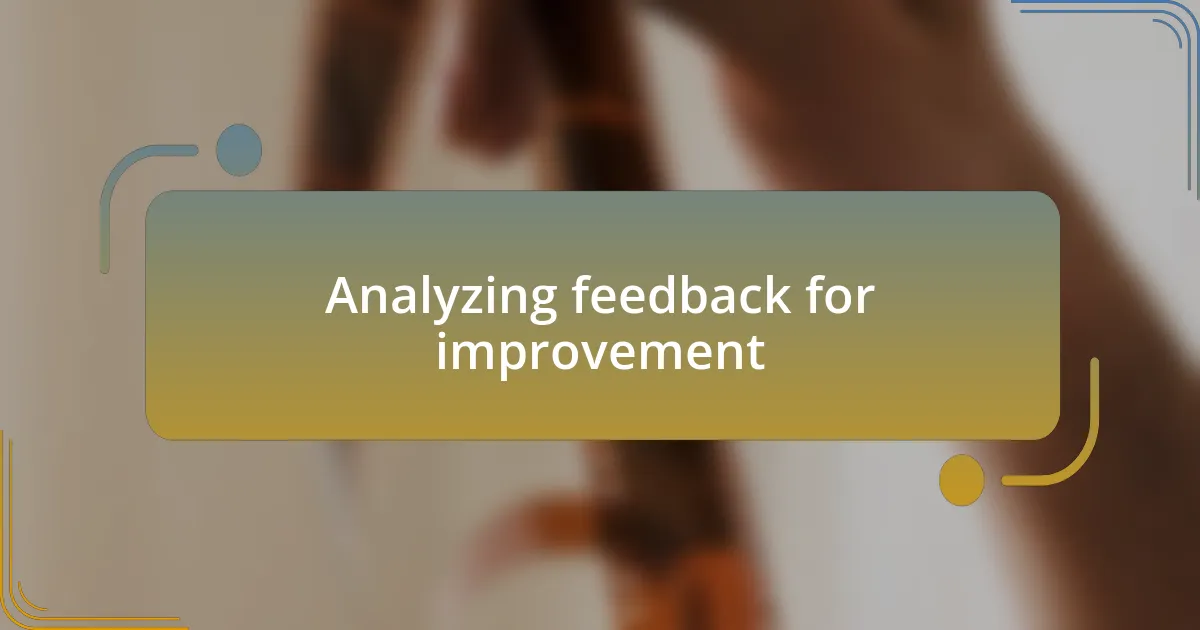
Analyzing feedback for improvement
When analyzing client feedback, I focus on identifying recurring themes and specific suggestions for improvement. Recently, after reviewing feedback from a series of workshops, I noticed several participants highlighted the need for more hands-on activities. This wasn’t just useful information; it was a clear signal that resonated with my own feelings about engagement in the learning process. Have you ever had that moment when feedback aligns perfectly with your own observations?
Sometimes, feedback can be challenging to interpret, especially when emotions run high. I’ll never forget receiving constructive criticism on one of my film project pitches. While my initial reaction was defensive, diving deeper into the comments revealed crucial insights about audience expectations. It taught me the importance of looking beyond the surface and embracing critiques as opportunities for growth. How often do we overlook the potential in what feels uncomfortable?
Moreover, I believe that sharing feedback with the entire team fosters a culture of openness and collective growth. After a recent project, I gathered the team to discuss client comments openly. This discussion didn’t just clarify what we could improve; it also sparked a healthy debate that fueled our creativity for future projects. Isn’t it fascinating how collaborative reflection can turn feedback into a catalyst for innovation?
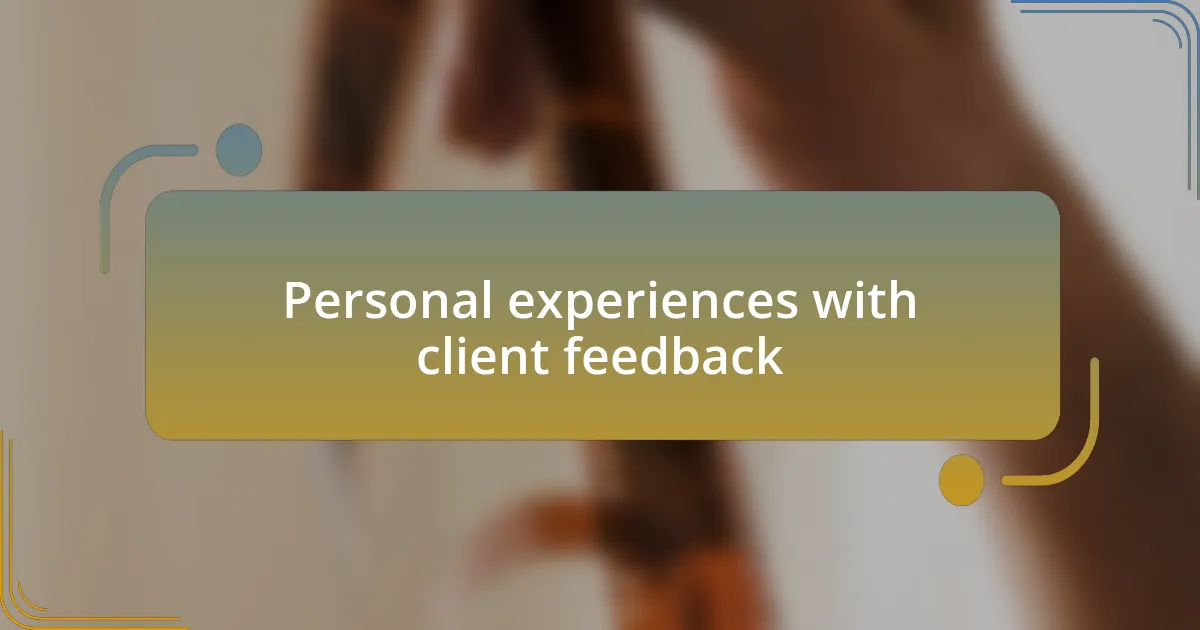
Personal experiences with client feedback
Receiving client feedback has often felt like a double-edged sword in my experience. For instance, during a recent film training course, a participant expressed their frustration with the pace of the lessons. At first, I bristled at the critique, but as I reflected on it, I realized that many learners share this concern. Have you ever sensed that what you perceive as a minor issue is actually a major barrier for others?
One moment etched in my memory was when a client pointed out that my teaching style sometimes overshadowed the content. Initially, my pride took a hit, but this comment prompted a shift in my approach. I began prioritizing clarity in my sessions, allowing the material to shine through while still injecting my personality. Isn’t it surprising how feedback can push us to evolve in ways we never anticipated?
I’ve found that celebrating positive feedback is just as crucial as addressing the negative. A client once praised a specific exercise for its impact, which encouraged me to incorporate similar activities more regularly. This acknowledgment wasn’t just flattering; it became a guiding light for tailoring my curriculum to meet audience needs. How do you ensure that positive insights fuel your growth as well?
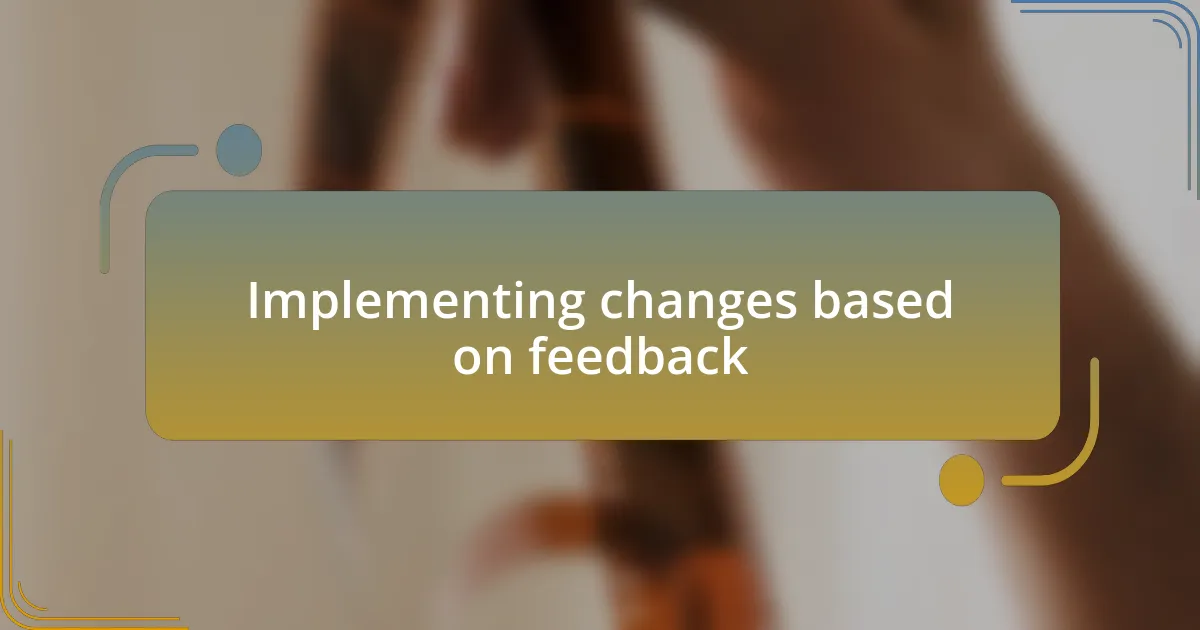
Implementing changes based on feedback
Implementing changes based on feedback can be an enlightening journey. I recall a specific situation where participants felt the lectures lacked real-world application. Instead of dismissing their views, I took it to heart, redesigning the curriculum to incorporate case studies from actual film projects. The transformation was not just for them; it revitalized my passion for teaching as well. Have you ever found that by adapting, you also rekindle your excitement for your craft?
Another memorable instance involved technical difficulties experienced by students during live sessions. Initially, my response was to defend the tools I used, but I soon realized that refusing to adapt only frustrated them further. I embraced this feedback by experimenting with alternative platforms and methods. The result? A more seamless experience that made learning enjoyable. Isn’t it remarkable how flexibility in response to critique can enhance not just client satisfaction but also the overall educational environment?
Finally, one piece of feedback still echoes in my mind, reminding me of the importance of continuous improvement. A client once suggested deeper discussions on directing techniques, which inspired me to craft specific workshops. Seeing them engage passionately in these tailored sessions reinforced my belief that feedback is a catalyst for innovation. How often do we overlook the potential for growth that lies within our clients’ insights?